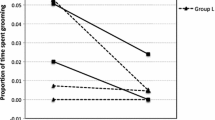Abstract
Social relationships of 30 infants with their maternal grandmothers were studied in a captive colony of vervet monkeys (Cercopithecus aethiops sabaeus).Grandmothers and grandinfants formed affiliative relationships with one another that could be distinguished from the infant’s relationships with nonkin adult females and with other adult female kin. The intensity of the grandmother—grandinfant relationship varied according to several factors which were related to the infant’s vulnerability to mortality and to the grandmother’s ability to provide effective social support. High-ranking grandmothers spent more time near their grandinfants, and initiated more grooming and caretaking of their grandinfants, than did lower-ranking grandmothers. Grandmothers spent more time near their daughter’s first surviving infant than near later-born infants, and when grandmothers had more than one adult daughter, they spent more time near the infant of the younger daughter. These results, combined with the fact that the presence of a maternal grandmother has been associated with a reduction in the rate of infant mortality in this colony (Fairbanks and McGuire, 1986), suggest that grandmothers are actively contributing to the reproductive success of their adult daughters and to the survival of their infant grandoffspring.
Similar content being viewed by others
References
Altmann, J. A. (1980). tBaboon Mothers and Infants, Harvard University Press, Cambridge, Mass.
Berman, C. M. (1982). The ontogeny of social relationships with group companions among free-ranging infant rhesus monkeys. I. Social networks and differentiation.Anim. Behav. 30: 149–162.
Berman, C. M. (1983). Influence of close female relatives on peer-peer rank acquisition. In Hinde, R. A. (ed.), Primate Social Relationships: An Integrated Approach, Sinauer Press, Sunderland, Mass., pp. 157–159.
Bernstein, I. S., and Ehardt, C. L. (1985). Agonistic aiding: Kinship, rank, age and sex influences.Am. J. Primatol. 8: 37–52.
Chapais, B., and Schulman, S. (1980). An evolutionary model of female dominance relations in primates.J. theoret. Biol. 82: 47–89.
Cheney, D. L. (1978). Interactions of immature male and female baboons with adult females.Anim. Behav. 26: 389–408.
Chepko-Sade, B. D., and Sade, D. S. (1979). Patterns of group splitting within matrilineal kinship groups: A study of social group structure inMacaca mulatto (Cercopithecidae: Primates).Behav. Ecol. Sociobiol. 5: 67–87.
Collins, D. A., Busse, C. D., and Goodall, J. (1984). Infanticide in two populations of savannah baboons. In Hausfater, G., and Hardy, S. B. (eds.),Infanticide: Comparative and Evolutionary Perspectives, Aldine, Hawthorne, New York, pp. 173–191.
Drickamer, L. C. (1974). A ten-year summary of reproductive data for free-ranging Macaca mulatto.Folia primatol. 21: 61–80.
Fairbanks, L. A. (1980). Relationships among adult females in captive vervet monkeys: testing a model of rank-related attractiveness.Anim. Behav. 28: 853–859.
Fairbanks, L. A. (1988). Vervet monkey grandmothers: Effects on mother-infant relationships.Behaviour 104: 176–188.
Fairbanks, L. A., and McGuire, M. T. (1984). Determinants of fecundity and reproductive success in captive vervet monkeys.Am. J. Primatol. 7: 27–38.
Fairbanks, L. A., and McGuire, M. T. (1985). Relationships of vervet mothers with sons and daughters from one through three years of age.Anim. Behav. 33: 40–50.
Fairbanks, L. A., and McGuire, M. T. (1986). Aging and dominance-related behavior in vervet monkey females: Reproductive value or cross-generational inheritance of dominance rank.Anim. Behav. 34: 1710–1721.
Fisher, R. A. (1930).The Genetical Theory of Natural Selection, Clarendon Press, Oxford.
Glick, B. B., Eaton, G. G., Johnson, D. F., and Worlein, J. M. (1986a). Social behavior of mother and infant Japanese macaques (Macaca fuscata): Effects of kinship, partner sex, and infant sex.Int. J. Primatol. 7: 139–155.
Glick, B. B., Eaton, G. G., Johnson, D. F., and Worlein, J. M. (1986b). Development of partner preferences in Japanese macaques (Macaca fuscata): Effects of gender and kinship during the second year of life.Int. J. Primatol. 7: 467–479.
Hamilton, W. D. (1964). The genetical evolution of social behavior. I, II.J. theoret. Biol. 7:1–52.
Horrocks, J., and Hunte, W. (1983). Maternal rank and offspring rank in vervet monkeys: An appraisal of the mechanisms of rank acquisition.Anim. Behav. 31: 772–782.
Itani, J. (1959). Paternal care in the wild Japanese monkey, Macaca fuscata fuscata.Primates 2: 61–93.
Kurland, J. A. (1977).Kin Selection in Japanese Monkey (Contributions to Primatology, Vol. 12), S. Karger, Basel, Switzerland.
Sade, D. S. (1965). Some aspects of parent-offspring and sibling relationships in a group of rhesus monkeys, with a discussion of grooming.Am. J. phys. Anthrop. 23: 1–18.
Seyfarth, R. M. (1977). A model of social grooming among adult female monkeys.J. theoret. Biol. 65: 671–698.
Silk, J. B. (1982). Altruism among female Macaco radiata: Explanations and analysis of patterns of grooming and coalition formation.Behaviour 79: 162–188.
Silk, J. B., Samuels, A., and Rodman, P. (1981). The influence of kinship, rank, and sex on affiliation and aggression between adult female and immature bonnet macaques (Macaca radiata).Behaviour 78: 111–137.
Struhsaker, T. T. (1971). Social behaviour of mother and infant vervet monkeys (Cercopithecus aethiops).Anim. Behav. 19: 233–250.
Whitten, P. L. (1983). Diet and dominance among female vervet monkeys (Cercopithecus aethiops).Am. J. Primatol. 5: 139–159.
Wilson, M. E., Gordon, T. P., and Bernstein, I. S. (1978). Timing of births and reproductive success in rhesus monkey social groups.J. med. Primatol. 7: 202–212.
Wilson, M. E., Walker, M. L., and Gordon, T. P. (1983). Consequences of first pregnancy in rhesus monkeys.Am. J. phys. Anthrop. 61: 103–110.
Yamada, M. (1963). A study of blood-relationships in the natural society of the Japanese macaque.Primates 4: 43–66.
Author information
Authors and Affiliations
Rights and permissions
About this article
Cite this article
Fairbanks, L.A. Vervet monkey grandmothers: Interactions with infant grandoffspring. Int J Primatol 9, 425–441 (1988). https://doi.org/10.1007/BF02736218
Received:
Revised:
Issue Date:
DOI: https://doi.org/10.1007/BF02736218




